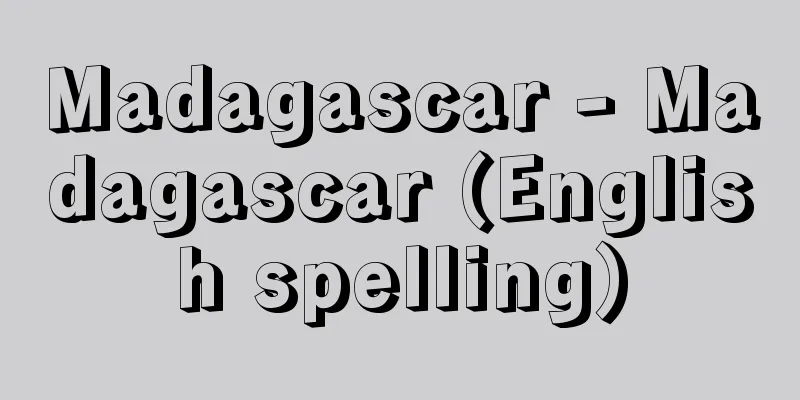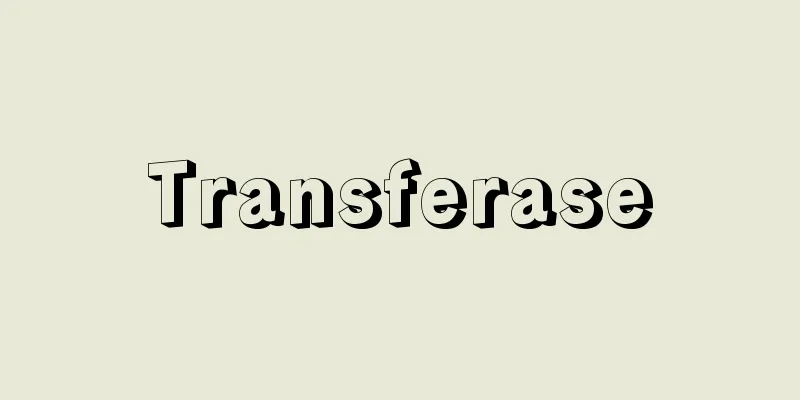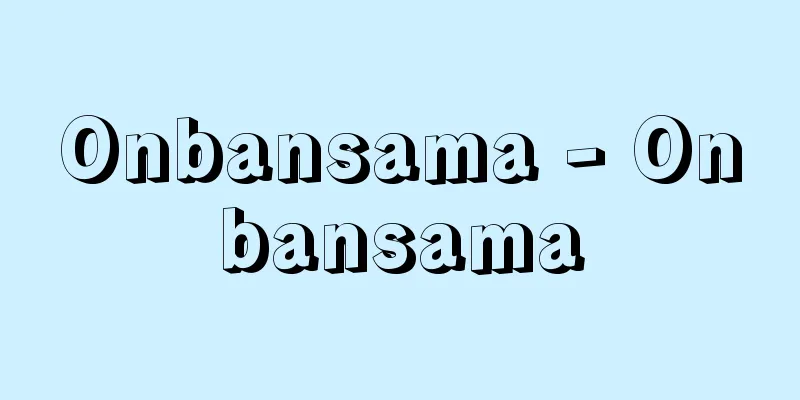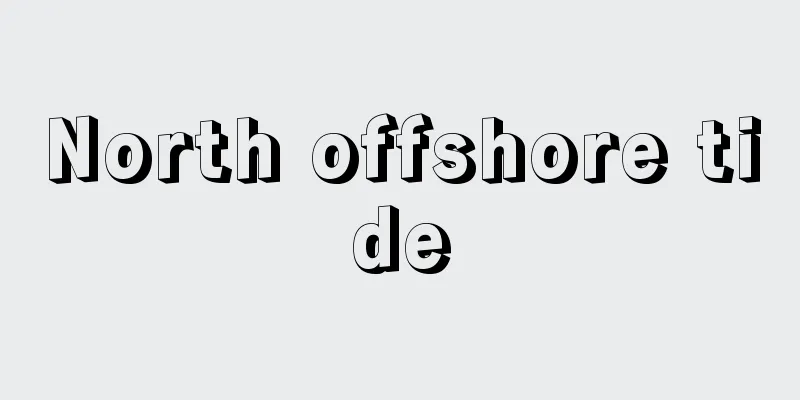Madagascar - Madagascar (English spelling)

|
An island nation in the Indian Ocean, 392 km east of the southeastern African continent across the Mozambique Channel. Officially the Republic of Madagascar. It consists of the world's fourth largest island, Madagascar, and small islands off the coast. It has an area of 587,041 square kilometers and a population of 15.97 million (estimated as of 2000). Its capital is Antananarivo (formerly Tananarive). [Akifumi Hayashi] Nature and GeographyMadagascar is a mountain range that runs from north to south, and the eastern side of the mountain range drops steeply into the Indian Ocean, forming a narrow eastern coastline. On the other hand, the western side of the island slopes gently into the Mozambique Channel, forming a wide plain. The island's highest peak, Mount Tsaratanana (2,886 meters), is located in the northern province of Antiranana. The northwestern plain is a grain-producing region, while the southwestern plain is a region where rice, cotton, tobacco, and cassava are cultivated. The southern tip is rich in mineral resources, and the eastern coastline is hot, making it suitable for the cultivation of coffee, vanilla, cloves, and sugar cane, and has the largest port, Tamatave (Toamasina). The central highlands are the administrative and cultural center, including the capital, Antananarivo. The climate is highly varied, with a tropical climate with high rainfall in the east and northwest, a dry climate in the west and south, and a temperate climate in the central highlands. [Akifumi Hayashi] FaunaAlthough it is relatively close to the African continent at about 400 km, its fauna is unique, and in zoogeography it is classified as part of the Malagasy subregion of the Paleotropics together with neighboring islands such as the Seychelles. In general, the number of species is not large, and it is closer to the Ethiopian subregion (Africa) than to the Oriental subregion (India, Southeast Asia), but there are many fauna endemic to Madagascar. Excluding the Chiroptera and those believed to have been brought in by humans, only four orders of mammals live in Madagascar: Insectivores, Primates, Rodentia, and Carnivora. The Tenrec family of Insectivores is endemic to Madagascar and has adapted and radiated into about 30 species, including terrestrial species similar to hedgehogs, subterranean species similar to moles, and aquatic species similar to water mice. The only primates that live in the country are the prosimian Lemuridae, Indriidae, and Aye-aye families, while the Rodentia (Civetidae) and Carnivora (Civetidae) are each divided into several unique genera. Among birds, the Madagascar shrikes and cuckoos have radiated adaptively, and the flightless bird species Rallidae and the extinct giant bird Aepyornis are well known. There are many other endemic species of animals, but not a single freshwater fish species inhabits the area. In the past, the existence of an ancient continent called Lemuria linking Africa and India was hypothesized to explain Madagascar's unique fauna, but this has now been rejected. [Akio Nizuma] VegetationThe island is generally dry, with a large area of savannah sparsely covered with trees such as Fabaceae (Caesalpiniaceae) and baobabs ( Adansonia ). The southern part is extremely dry, and is dominated by succulent plants such as Euphorbia and Pachypodium, and shrub communities of thorny plants. The eastern part of the island is mountainous, running north to south, where rainfall is somewhat higher and dense rain-green forests can be seen. The mountaintops are shrub forests of sclerophyllous trees, or heath-like communities of Ericaceae. The vegetation is similar to that of central Africa and the region from western India to the Sahara, but 85% of the total species are endemic, and there are five endemic families, including Didieraceae. Madagascar's vegetation is highly independent, and it is classified as the Madagascar region of the Paleotropical Flora Kingdom, along with the Seychelles. [Tatsuyuki Ohba] historyThe indigenous people of Madagascar are said to have originated from Southeast Asia, and after migrating to the east coast of the African continent, they migrated to the island of Madagascar around the 10th century. They then established the Kingdom of Andriana (later the Merina Kingdom) in the central highlands in the early 17th century. The kingdom was a centralized kingdom consisting of the Andriana royal family, the nobility (hoba), and slaves (andebo), and its capital was Antananarivo. The first Europeans to arrive were the Portuguese in 1500, followed by the Dutch, British, and French. British and French missionaries began missionary work in the early 19th century, and consulates from both countries were established in 1862. In 1869, King Ranavalona II (1829-1883) converted to Christianity (Protestantism) and made it the state religion, after which Christianity spread throughout the country. As a result of the Berlin Conference of 1885, which decided the division of Africa, Malagasy became a French territory, but the Protestant Malagasy rebelled against the rule of Catholic France, and in 1895 France used force to suppress it. However, the Malagasy continued to rebel even after colonization. After the Menalamba Rebellion of 1896 and the rebellion of 1904 were suppressed, in 1913 they formed a nationalist movement organization called "Bi Bat Sakelika" (meaning "iron and stone") to resist French rule. During World War II, the colonial government supported the Vichy government of France, so in 1942 the British occupied Madagascar on the pretext of preparing for a Japanese invasion. The following year, in 1943, the British handed Madagascar over to the Free French government of de Gaulle. In March 1947, a large-scale resistance against French rule led by the Malagasy Revolutionary Democratic Movement (founded in 1946, leader Joseph Raseta, 1886-1979) broke out, but was suppressed with many casualties. In 1956, France enacted the Basic Law, granting the colony a large degree of autonomy. In the same year, P. Chiranana founded the Social Democratic Party (PSD) and became a Malagasy representative in the French parliament. In 1958, as France transitioned to the Fifth Republic, de Gaulle proposed the idea of a French Community, and in October of the same year Madagascar became an autonomous country within the Community, and on June 26, 1960, Madagascar officially gained independence from France, with Chiranana becoming its first president. After independence, Ciranana adopted a pro-Western (especially French) policy. In 1961, the heads of state of 12 former French colonies met in Antananarivo and played an important role in forming the African Malagasy Union (later the African Malagasy Cooperation Organization OCAM) for the purpose of economic and social cooperation. He also maintained friendly relations with the racist Republic of South Africa. In May 1972, the suppression of a student strike against Ciranana's policies led to a military coup, and Major General Gabriel Ramanantsoa (1906-1979) took power. [Akifumi Hayashi] Politics and DiplomacyRamanantsoa advocated state capitalism and replaced the parliament with the People's Council for National Development (CNPD). In 1973, the Council demanded the withdrawal of French troops, severed ties with the Republic of South Africa, and established diplomatic relations with the Soviet Union and Eastern Europe instead. At the same time, it withdrew from OCAM and the Franc Zone. In February 1975, a power struggle within the military led to Colonel Richard Ratsimandrava (1931-1975) taking power in place of Ramanantsoa, but he was assassinated six days later. General Gilles Andriamahazo (1919-1989) took full power and established a Military Council. In June of the same year, the Military Council appointed former Foreign Minister Didier Ratsiraka (1936-2021) as head of state. In December of the same year, Ratsiraka enacted a new constitution, dissolved the Military Council, and established the following institutions in its place: (1) the Supreme Revolutionary Council, chaired by Ratsiraka, (2) the government, headed by the Prime Minister, as the highest organ of the executive branch, (3) the People's National Assembly as the legislative branch, (4) the Supreme Constitutional Court as the judicial branch, and (5) the Military Development Committee as an advisory body for national defense and socio-economic development planning. Furthermore, he advocated a socialist approach to nation building, and stated that its foundation was the rural community (foconorona) encouraged by the government. In diplomacy, Ratsilaka continued the pro-Communist Ramanantsoa line, but relations with France were restored after an official visit to France in September 1978. In addition, the country joined the United Nations and the Organization of African Unity (now the African Union), and signed the second Lomé Agreement with the EC (European Community). On the other hand, the nationalization of major industries led to economic stagnation, an increase in unemployment, and intensifying inflation. As a result, in the 1980s, there were frequent coup attempts, worker strikes, student protests, and the burning of Indian shops. To overcome this crisis, Ratilanka began to implement economic liberalization policies with the support of the IMF (International Monetary Fund). In December 1991, a national unity government was formed by President of the Supreme National Assembly Albert Zafy (1927-2017) and Prime Minister Guy Willy Razanamasy (1928-2011), who called for anti-Ratiraka and anti-socialism. This government promised to hold a constitutional referendum and presidential and national assembly elections in 1992. In accordance with this promise, a constitutional referendum was held in August of that year, and the country was promised to abandon the socialist path and hold presidential and national assembly elections under a multi-party system, with Zafy taking office as the new president in the presidential election in November. However, public dissatisfaction with the Zafi administration's governing ability and its economic liberalization policies grew, and in May 1996 a motion of no confidence was passed, and in the runoff election held in December of the same year, Ratsiraka returned to the presidency with 50.7% of the vote. The presidential election held in December 2001 was contested between Ratsiraka and Antananarivo Mayor Marc Ravalomanana (1949-), but as the votes were counted, neither candidate received a majority, and a runoff election was held. However, in February 2002, Ravalomanana was declared the winner of the election, claiming that there had been fraud in the results, resulting in an abnormal situation in which there were two presidents. There was great confusion, with military forces supporting each president clashing with each other, but in July Ratsiraka escaped to the Seychelles with his family, and the conflict ended with Ravalomanana's victory. The military consists of approximately 20,000 army personnel, 600 navy personnel, and 500 air force personnel; the air force has received assistance from the Soviet Union and North Korea since 1978 and therefore possesses eight MiG-21 fighter jets. [Akifumi Hayashi] Economy and IndustryMadagascar is an agricultural country, with agriculture accounting for about 40% of the country's gross domestic product (GDP), and about 80% of the total working population being engaged in agriculture. The country's main agricultural products are rice, sugarcane, coffee, vanilla, cloves, pepper, cotton, sisal, beans, groundnuts, and tobacco. In addition, since independence, palm oil and tea cultivation has been promoted on the eastern coast. Coffee and sugarcane plantations run by the French were nationalized in 1977. The country is also rich in mineral resources, with the main products being graphite, mica, chromium, bauxite, uranium, and gemstones such as amethyst and garnet. However, most of the mining of these minerals is carried out by foreign companies. In recent years, oil exploration has been carried out by the United States, France, and Italy. Iron ore veins have also been discovered in Soarara in the northwest. Manufacturing is underdeveloped and the country is dependent on imports for industrial products. The few industries that do exist are mostly agricultural product processing, with other industries including cement, paper, pulp, petroleum refining, shoemaking, matches, chemical fertilizers, plastics processing, automobile assembly, and transistor radio assembly, mostly concentrated in the capital, Antananarivo, as well as Antisiraba, Majunga, Diego Suarez (Antirana), and Tamatave (Toamasina). The Andecarella hydroelectric plant is under construction with assistance from Canada, Iraq, and France. The main exports are primary agricultural and mineral products, while machinery, transportation equipment, industrial products, food, and oil make up the majority of imports. Trade partners include France, the United States, Germany, and Japan, and the country continues to have a chronic trade deficit. For transportation, there are approximately 50,000 km of roads in the mountain range centered on the capital and on the northwest coast, but the east coast is underdeveloped. At present, the World Bank, China, Kuwait, and the African Development Bank are providing assistance for a road extension plan. The main railway lines run between Tamatave, Antananarivo, and Antisirava, and between Fianarantsoa and Manakara, but there are no lines to the west coast. The main port is Tamatave on the east coast. International flights are provided by Air France, Air Italy, and Air Madagascar, which mainly connect various parts of the country. The Ratsiraka government had pursued a socialist controlled economy since 1975, but it failed, and from 1983 onwards, with the assistance of the International Monetary Fund (IMF) and the World Bank, the Structural Adjustment Programme (SAP) was implemented, which resulted in an economic recovery with an economic growth rate of 4% in 1989. However, due to political instability since 1991 and damage caused by a major cyclone (typhoon) in 1994, the economy has fallen into a slump again. [Akifumi Hayashi] Society and CultureAccording to the 1993 census, the population is about 13.5 million, including 30,000 Europeans (mainly French), 15,000 Indians, and 9,000 Chinese. The Indians and Chinese are mainly engaged in commerce. Malagasy, a Malayo-Polynesian language, is the official language, but French and English are also taught in schools. Gross National Income (GNI) per capita is low at $250 (2000). More than 80% of the economically active population is engaged in agriculture, with 10% in the service industry and only 4% in industry. The education system is French-style, with elementary school ages 6-14 being compulsory, and there are 13,672 public and private elementary schools with a total of 1,534,142 students. There are 1,142 junior high schools, 366 high schools, and 6 universities (1994). After King Ranavalona II of the Merina dynasty converted to Christianity, Protestantism spread throughout the country, but Catholicism also spread through French colonization, and currently 26% of the population is Catholic and 22% is Protestant. Although Madagascar is an island in the southern part of the African continent, it differs from other Black African countries in that it has a unique ethnic composition of Malay-Polynesian descent and an original culture represented by rice cultivation. [Akifumi Hayashi] residentsMadagascar is home to many ethnic groups, many of whom speak different dialects, but they all share one common language that can be called Malagasy (Malagasy). It is classified as an Austronesian language, and culturally, the people have clear ties to Southeast Asia. Physical connections with Southeast Asia can also be seen, and the inhabitants of the central and eastern parts of the country are particularly similar to the ethnic groups of Indonesia. The Sakalava, Bezo, and Antandroy cultures are of Southeast Asian origin, but are influenced by East African cultures, such as their emphasis on cattle and their rites of royal ancestor worship. On the other hand, the black cultures of the Tanara and Betsimisaraka have no discernible connection to Africa. Madagascar's ethnic groups can be broadly divided into three groups based on their habitat and ecological environment. The peoples of the west coast and south live in dry pastures and practice a mixed economy of agriculture and animal husbandry. The Sakalava are the representatives, and they established a powerful kingdom after the 15th century. The Merina and Betsileo live in the central highlands and practice irrigated rice cultivation. Tombs play an important role in their lives and are a symbol of family. The peoples who live in the forest areas of the east coast cultivate upland rice, bananas, and corn, and also engage in fishing. The Tanara are well known in this region, and Tanara means "people of the forest" and includes many ethnic groups. The influence of Islamic Arab and Swahili culture is strong throughout Madagascar. It is believed that Arabs established trading posts around the 8th century. [Yasushi Kato] "Ministry of Foreign Affairs Supervised 'World Country Handbook Series 47: Republic of Madagascar, Mauritius' (1973, Japan Institute of International Affairs)" ▽ "Hubert Deschamps, translated by Kimura Masaaki, 'Madagascar' (1989, Hakusuisha)" ▽ "Yoichi Yamaguchi, 'Madagascar: The Asian Country Closest to Africa' (1991, Simul Publishing)" [Supplementary Material] |"> Madagascar flag ©Shogakukan Illustration/Shogakukan Creative "> Madagascar Location Map Source: Shogakukan Encyclopedia Nipponica About Encyclopedia Nipponica Information | Legend |
|
アフリカ大陸の南東部から、モザンビーク海峡を隔てて392キロメートル東のインド洋にある島国。正称マダガスカル共和国République de Madagascar。世界第四の大島マダガスカル島と沿岸の小島からなる。面積58万7041平方キロメートル、人口1597万(2000推計)。首都はアンタナナリボ(旧称タナナリブ)。 [林 晃史] 自然・地誌マダガスカル島は南北に脊梁(せきりょう)山脈が走り、その東側は急傾斜でインド洋に落ち込み狭い東部海岸線をなす。一方、西側は緩い傾斜でモザンビーク海峡に延び、広い平野部を形成している。北部のアンチラナナ州には島の最高峰ツァラタナナ山(2886メートル)がある。北西部の平野は穀倉地帯、南西部の平野は米、綿花、タバコ、キャッサバの栽培が盛んである。南端部は鉱産資源が豊富であり、東部海岸線は暑く、コーヒー、バニラ、チョウジ、サトウキビの栽培に適し、最大の港タマタブ(トアマシナ)がある。中央高地は首都アンタナナリボを含む行政、文化の中心地である。気候は、東部、北西部の雨量の多い熱帯性気候、西部、南部の乾燥地域気候、中央高地の温帯気候と変化に富んでいる。 [林 晃史] 動物相アフリカ大陸からの距離は約400キロメートルと比較的近いが動物相は特異であり、動物地理学上はセイシェル諸島など隣接諸島とあわせて旧熱帯区のマダガスカル亜区として区分される。概して種類数は多くなく、東洋亜区(インド、東南アジア)よりはエチオピア亜区(アフリカ)に近いが、マダガスカル特産の動物群が多い。 哺乳(ほにゅう)類は翼手(よくしゅ)類と人間が持ち込んだとみなされるものを除くと、食虫類、霊長類、齧歯(げっし)類、食肉類の4目だけが生息する。食虫目のテンレク科はマダガスカル特産で、ハリネズミに似た地上性の種、モグラに似た地中性の種、カワネズミに似た水生の種など約30種に適応放散している。霊長目は原猿類のキツネザル科、インドリ科、アイアイ科だけが生息し、齧歯目(キヌゲネズミ類)と食肉目(ジャコウネコ類)は固有のそれぞれ数属に分類される。 鳥類ではマダガスカルモズ類やジカッコウ類が適応放散し、飛べない鳥のクイナモドキ科の特産種や絶滅した巨鳥のエピオルニスがよく知られている。その他の動物群にも特産種が多いが、淡水魚は一種も生息しない。 かつて、マダガスカルの特異な動物相を説明するため、古代にアフリカとインドを結ぶレムリア大陸があったと想定されたが、現在では否定されている。 [新妻昭夫] 植生全般に乾燥していてマメ科(ジャケツイバラ亜科)やバオバブ類(アダンソニアAdansonia)などの樹木の疎生するサバンナの面積が広い。南部は乾燥が厳しく、ユーフォルビア、パキポディウムなどの多肉植物と、刺(とげ)植物の低木群落で占められる。島の東部寄りには南北に走る山地があり、ここではやや雨量が多く、密集した雨緑林がみられる。山頂部は硬葉樹の低木林、あるいはツツジ科のヒース状の群落となっている。種類相は、アフリカ中部、およびインド西部からサハラにかける地域と類縁をもつが、総種数の85%が固有種で、ディディエレア科など五つの固有の科がある。マダガスカルの植生は独立性が高く、セイシェル島などとともに旧熱帯植物区系界のなかにマダガスカル区系区としてまとめられる。 [大場達之] 歴史マダガスカルの先住民は東南アジア出身で、アフリカ大陸の東海岸に移住したのち、10世紀ごろマダガスカル島に移住したといわれる。そして17世紀初頭、中央高地にアンドリアナ王国(後のメリナ王国)を建設した。王国はアンドリアナ王家と貴族階級(ホバ)、奴隷(アンデボ)からなる中央集権的王国であり、王都はアンタナナリボに置かれた。ヨーロッパ人の渡来は1500年のポルトガル人が最初で、オランダ、イギリス、フランスがこれに次いだ。 19世紀初頭にイギリスとフランスの宣教師による布教活動が始まり、1862年に両国の領事館が置かれた。1869年ラナバロナ2世(1829―1883)がキリスト教(プロテスタント)に改宗し国教として以降、キリスト教は全土に広がった。アフリカ分割を決めた1885年のベルリン会議の結果フランス領となったが、カトリック国フランスの支配に対しプロテスタントのマダガスカル人は反抗し、1895年フランスは武力を用いて制圧した。しかし植民地化以後もマダガスカル人の反抗は続いた。1896年のメナラムバの反乱、1904年の反乱が鎮圧されたのち、1913年には民族運動組織「ビ・バト・サケリカ」(「鉄と石」の意)を結成しフランスの支配に抵抗した。 第二次世界大戦中に植民地政府がフランスのビシー政府を支持したため、1942年イギリス軍は日本軍の侵攻に備えることを口実にマダガスカルを占領した。翌1943年イギリスはマダガスカルをドゴールの自由フランス政府に引き渡した。1947年3月、フランス支配に対しマダガスカル革命民主運動(1946結成。党首ラセタJoseph Raseta、1886―1979)の指導による大規模な抵抗が起こり、多数の犠牲者を出して鎮圧された。1956年フランスは基本法を制定して植民地に対し大幅な自治を認めた。同年P・チラナナは社会民主党(PSD)を結成し、フランス議会のマダガスカル代表議員となった。1958年フランスの第五共和政移行とともにドゴールがフランス共同体構想を打ち出したため、同年10月マダガスカルは同共同体内の自治国となり、1960年6月26日フランスから正式に独立してチラナナが初代大統領となった。 独立後、チラナナは親西欧(とくにフランス)政策をとった。1961年には旧フランス領12か国の元首がアンタナナリボに集まって経済、社会面での協力を目的とするアフリカ・マダガスカル連合(のちアフリカ・マダガスカル共同機構OCAM)を結成するのに重要な役割を果たした。さらに人種主義の南アフリカ共和国とも友好関係を保った。1972年5月、チラナナの政策に反対する学生のストライキに対する弾圧を契機に、軍隊がクーデターを起こし少将ラマナンツォアGabriel Ramanantsoa(1906―1979)が政権を握った。 [林 晃史] 政治・外交ラマナンツォアは国家資本主義を標榜(ひょうぼう)し、議会にかわって人民国家開発評議会(CNPD)を置いた。同評議会は1973年フランス軍の撤退を要求し、南アフリカ共和国との関係を断ち、かわりにソ連、東欧と外交関係を樹立した。同時にOCAMおよびフラン圏からも脱退した。1975年2月軍内部の権力抗争によって大佐ラチマンドラバRichard Ratsimandrava(1931―1975)がラマナンツォアにかわって政権を掌握したが、6日後に暗殺され、将軍アンドリアマハゾGilles Andriamahazo(1919―1989)が全権を掌握して軍評議会を設置した。同年6月軍評議会は国家元首として新たに元外相ラチラカDidier Ratsiraka(1936―2021)を任命した。ラチラカは同年12月新憲法を制定するとともに軍評議会を解散し、かわって以下の諸機構を設置した。(1)ラチラカを議長とする最高革命評議会、(2)行政府の最高機関として首相を長とする政府、(3)立法府として人民国民議会、(4)司法府として立憲最高裁判所、(5)国防・社会経済開発計画諮問機関として軍事開発委員会の五つである。さらに国家建設の方向として社会主義路線を主唱し、その基盤は政府の奨励する農村共同体(フォコノローナ)にあるとした。 外交面ではラチラカは共産圏よりのラマナンツォア路線を継承したが、1978年9月のフランス公式訪問ののち対仏関係は修復された。そのほか国連、アフリカ統一機構(現アフリカ連合)にも加盟し、EC(ヨーロッパ共同体)との第二次ロメ協定にも調印した。 一方、主要産業を国有化したため経済が停滞し、失業者の増加、インフレの激化を招いた。そのため1980年代には、クーデター未遂事件、労働者のストライキ、学生の抗議行動、インド人商店の焼打ちなどが頻発した。この危機を打開するためラチラカはIMF(国際通貨基金)の支援を得て経済自由化政策をとり始めた。 1991年12月、反ラチラカ、反社会主義を要求して国家最高機関総裁ザフィAlbert Zafy(1927―2017)と首相ラザナマシGuy Willy Razanamasy(1928―2011)による挙国一致内閣が成立した。同内閣は1992年に改憲国民投票、大統領・国民議会選挙を実施することを約束した。その約束に従い、同年8月改憲国民投票が実施され、社会主義路線の放棄、複数政党制下の大統領、国民議会選挙が約束され、11月の大統領選挙でザフィが新大統領に就任した。 しかし、その後ザフィ政権の統治能力、経済自由化政策に対する国民の不満が高まり、1996年5月に内閣不信任案が可決され、同年12月に実施された大統領選挙の決選投票でラチラカは50.7%の得票率で大統領に返り咲いた。2001年12月に行われた大統領選はラチラカとアンタナナリボ市長のラバロマナナMarc Ravalomanana(1949― )で争われたが、開票の結果、両者ともに過半数に至らず、決選投票を行うことになった。しかしこの開票結果に対して、不正が行われたとして2002年2月にラバロマナナが大統領当選を宣言し、2人の大統領が存在するという異常事態となった。それぞれの大統領を支持する軍どうしが衝突するなど混乱をきわめたが、7月にラチラカは家族とともにセイシェルに脱出し、ラバロマナナの勝利で対立は終結した。 軍隊は、陸軍約2万人、海軍600人、空軍500人で、空軍は1978年以降ソ連と北朝鮮の援助を受けていたため、ミグ21型戦闘機8機を有する。 [林 晃史] 経済・産業マダガスカルは農業立国であり、国内総生産(GDP)に占める農業の割合は約40%、全就業人口の約80%が農業に従事している。主要農産物は米、サトウキビ、コーヒー、バニラ、チョウジ、コショウ、綿花、サイザル麻、豆類、ラッカセイ、タバコである。さらに独立以降、東部海岸でパーム油と茶の栽培が進められている。フランス人によって経営されていたコーヒーやサトウキビのプランテーションは1977年国有化された。 鉱産資源も豊富で、主要鉱産物として黒鉛、雲母(うんも)、クロム、ボーキサイト、ウランなどのほかアメシ(ジ)スト、ガーネットなどの宝石も産出する。ただしこれらの鉱産物採掘はほとんど外資系企業により行われている。近年石油探査がアメリカ、フランス、イタリアによって行われている。また北西部のソアララで鉄鉱脈が発見された。 製造工業は未発達で、工業製品は国外からの輸入に依存している。わずかにある工業は農産物加工がほとんどで、その他の工業にセメント、紙、パルプ、石油精製、製靴、マッチ、化学肥料、プラスチック加工、自動車組立て、トランジスタ・ラジオ組立てなどがあり、そのほとんどは首都アンタナナリボのほか、アンチシラバ、マジュンガ、ディエゴ・スアレス(アンチラナナ)、タマタブ(トアマシナ)に集中している。カナダ、イラク、フランスの協力でアンデカレラ水力発電所が建設中である。 主要輸出品は農・鉱産物の一次産品で、機械、輸送器機、工業品、食糧、石油が輸入の大半を占める。貿易相手国はフランス、アメリカ、ドイツ、日本など、恒常的な入超で赤字が続いている。 交通は首都を中心とする脊梁(せきりょう)山脈部と北西海岸部を中心に全長約5万キロの道路があるが、東海岸部は未発達である。現在道路延長計画に世界銀行、中国、クウェート、アフリカ開発銀行が援助している。鉄道はタマタブ―アンタナナリボ―アンチシラバ間とフィアナランツォア―マナカラ間のものが主要路線で、西海岸へ通ずるものはない。主要港は東海岸のタマタブである。国際航空便はフランス航空、イタリア航空で、マダガスカル航空はおもに国内各地を結んでいる。 ラチラカ政権は1975年以来社会主義統制経済を進めたが失敗し、1983年以降、IMF(国際通貨基金)、世界銀行の支援で構造調整計画(SAP)を実施した結果、1989年には経済成長率4%となり、経済は回復した。しかし、1991年以降の政情不安定と1994年の大型サイクロン(台風)の被害により経済はふたたび低迷している。 [林 晃史] 社会・文化1993年実施のセンサスによる人口約1350万のうち、ヨーロッパ人(主としてフランス人)3万人、インド人1万5000人、中国人9000人を含む。インド人、中国人はおもに商業に従事している。マレー・ポリネシア系のマダガスカル語が公用語となっているが、フランス語、英語も学校で教えられている。1人当りの国民総所得(GNI)は250ドル(2000)と低い。経済活動人口の80%以上は農業に従事しており、サービス産業就業者が10%、工業労働者はわずか4%である。 教育制度はフランス式で、6~14歳が小学生で義務教育にあたり、小学校は公立・私立含めて1万3672校、生徒数は約153万4142人。中学校は1142校、高等学校は366校、大学は6校ある(1994)。 メリナ王朝のラナバロナ2世がキリスト教に改宗して以来プロテスタントが全土に広まったが、その後フランスの植民地化を通してカトリックも広がり、現在カトリック教徒は26%、プロテスタント教徒22%である。マダガスカルはアフリカ大陸南部の島でありながら、ほかのブラック・アフリカ諸国と異なり、マレー・ポリネシア系の独特の民族構成と稲作に代表される独自の文化をもっている。 [林 晃史] 住民マダガスカルには多くの民族が住んでいて、各方言に分かれるが、マダガスカル(マラガシー)語とよびうる一つの共通言語を話す。これはオーストロネシア語族に分類され、文化的にも東南アジアとの関連が顕著である。身体的にも東南アジアとのつながりが認められ、とくに中部および東部の住民はインドネシアの諸民族に似ている。サカラバ、ベゾ、アンタンドロイなどの文化は東南アジア系であるが、ウシを重視し王族祖先崇拝の儀礼をもつなど東アフリカの文化の影響がある。一方、黒人系のタナラやベツィミサラカの文化はアフリカとのつながりが認められない。 マダガスカルの諸民族は居住地域および生態環境の面から三つの集団に大別することができる。西海岸と南部の諸民族は乾燥した牧草地に住んでいて農耕と牧畜の混合経済を営む。代表はサカラバで、15世紀以降強大な王国を建設した。中部高原にはメリナとベツィレオが住んでおり、灌漑(かんがい)稲作を行う。墓が生活のなかで重要な位置を占め家族の象徴でもある。東海岸の森林地帯に住む諸民族は陸稲やバナナ、トウモロコシを栽培し漁労も行う。この地域ではタナラがよく知られているが、タナラというのは「森の人」という意味で多くの民族集団を含む。マダガスカル全域でイスラム教アラブとスワヒリ文化の影響が強い。アラブ人は8世紀ころから交易場を設立していたと考えられる。 [加藤 泰] 『外務省監修『世界各国便覧叢書47 マダガスカル共和国・モーリシアス』(1973・日本国際問題研究所)』▽『ユベール・デシャン著、木村正明訳『マダガスカル』(1989・白水社)』▽『山口洋一著『マダガスカル―アフリカに一番近いアジアの国』(1991・サイマル出版会)』 [補完資料] |"> マダガスカルの国旗 ©Shogakukan 作図/小学館クリエイティブ"> マダガスカル位置図 出典 小学館 日本大百科全書(ニッポニカ)日本大百科全書(ニッポニカ)について 情報 | 凡例 |
>>: The Gospel According to Matthew
Recommend
Poor harvest - kyousaku
This refers to a severe crop failure, including g...
Sanskrit (English spelling)
A language belonging to the Indo-European branch o...
ejidatario
… The land of an ejido is governed by a different...
Bone metastasis cancer
All cancers that occur in the bones are called mal...
Enya Okihisa
...A medieval samurai family in Izumo. A branch o...
Charles Sealsfield
1793‐1864 Austrian author. His real name was Karl ...
Shan [state] - Shan
Eastern Myanmar, mainly inhabited by the Shan peop...
Coca
〘Noun〙 (coca originally Quechua) A shrub of the Co...
Mary (Therese) McCarthy
Born June 21, 1912 in Seattle, Washington, USA [Di...
Akenokane - Bell of Dawn
Nagauta. The lyrics and composer, and the date of ...
Xanthine - Kisanchin (English spelling) xanthine
A chemical substance present in living organisms,...
Qibt (English spelling)
…Egyptian Christians who belong to the Coptic Chu...
Katakana - Katakana
〘Noun〙 ("Kata" means not complete, a par...
Saadia Ben Joseph
882‐942 A Babylonian Jewish leader and the foremos...
Construction - kenchikusekou
The implementation procedure for construction wor...



![Alitalia Italian Airlines [company] - Alitalia Italian Airlines (English name) Alitalia Linee Aeree Italiane SpA](/upload/images/67cadccdbf50b.webp)





